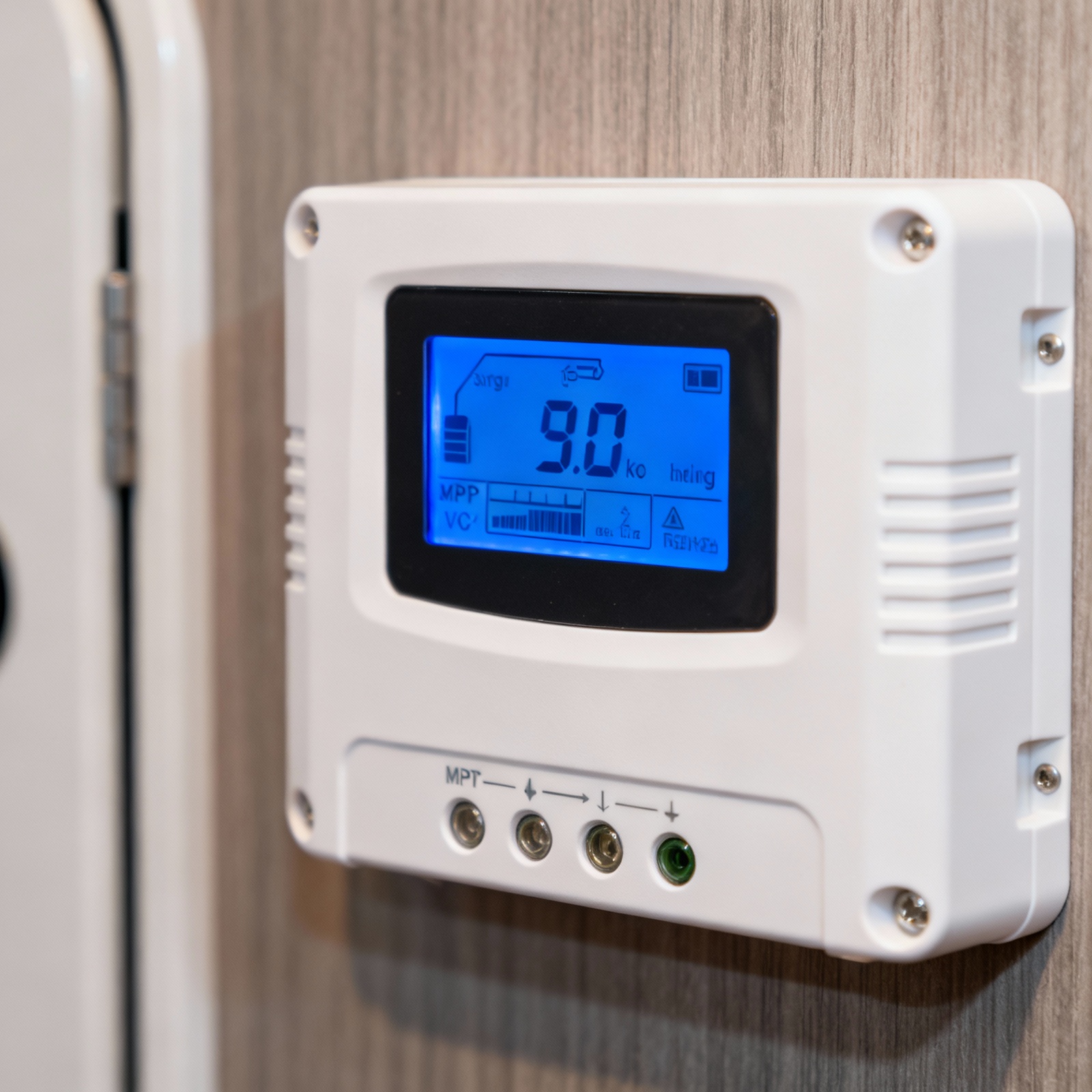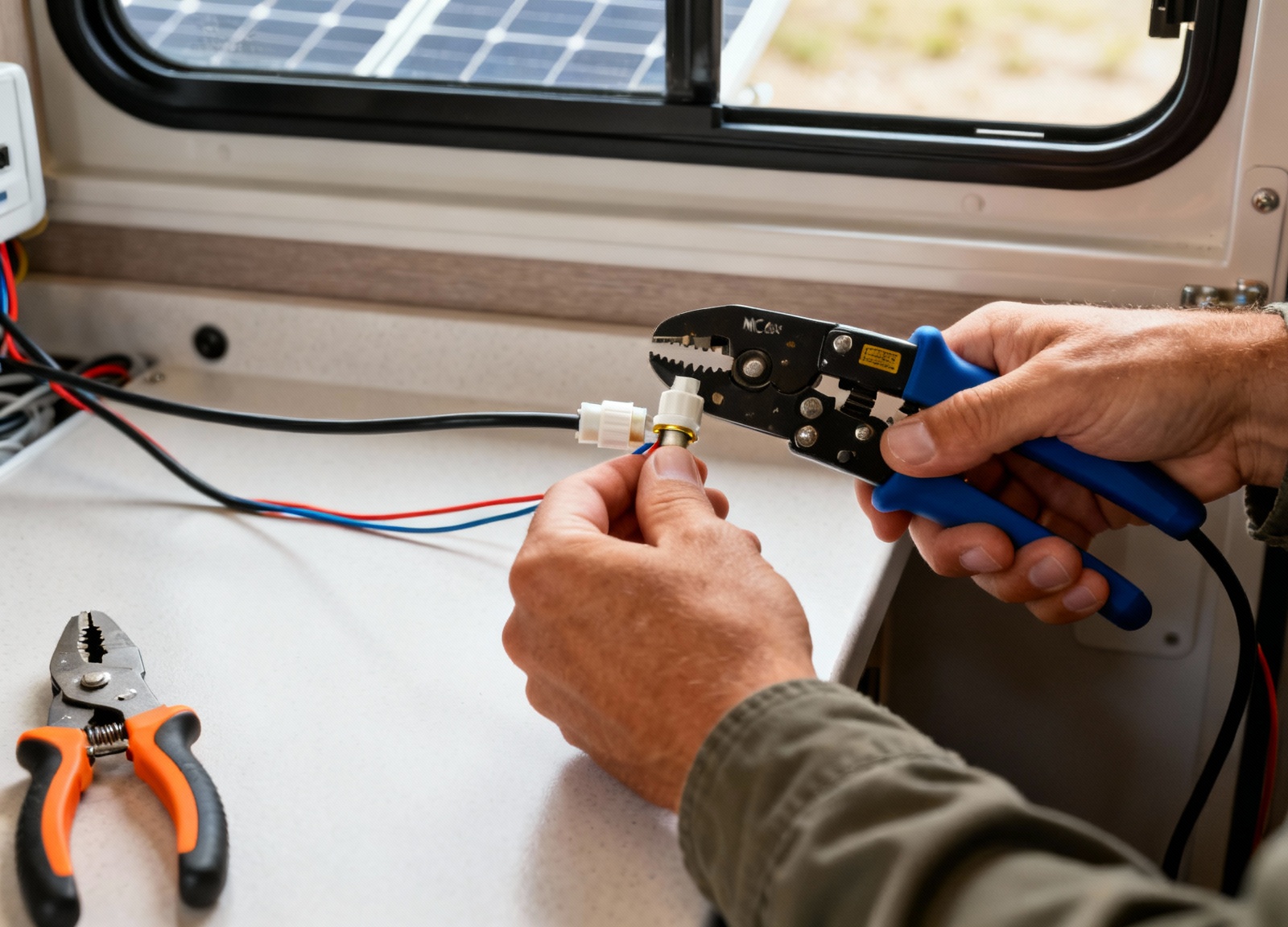
As an Amazon Associate, we earn from qualifying purchases.
Best RV Solar Picks

#1 Renogy 400W 12V Monocrystalline Solar RV Kit
Key Specs: 4x 100W monocrystalline panels, 40A MPPT controller, mounting brackets, 30ft 10AWG tray cables, 8ft 8AWG battery cables. View on Amazon
- Pro: Complete kit with MPPT controller optimizes charging in partial shade
- Pro: Monocrystalline panels deliver 21% efficiency even in low light
- Pro: Expandable up to 800W with same controller
- Con: Requires roof space for four separate 100W panels
- Con: No battery included in base kit
The Renogy 400W kit represents the gold standard for RV solar installations, combining proven monocrystalline technology with intelligent charge management. The four-panel configuration offers installation flexibility—you can arrange panels to work around roof vents, air conditioners, and satellite dishes. Each 100W panel measures 42.2 x 19.6 inches, compact enough to fit most RV roofs while providing substantial power generation.
The included 40A MPPT controller distinguishes this kit from budget alternatives. Maximum Power Point Tracking technology continuously adjusts voltage and current to extract optimal power from your panels, particularly valuable during morning and evening hours when sun angles reduce output. In real-world testing, MPPT controllers harvest 20-30% more energy than PWM controllers in partially cloudy conditions. The controller handles input voltages up to 100V, allowing series wiring configurations that reduce voltage drop over long cable runs.
Installation hardware quality exceeds industry standards. The corrosion-resistant aluminum Z-brackets withstand 2400Pa snow loads and 180mph wind resistance. Pre-drilled mounting holes align with standard RV roof structures, though you’ll need to purchase appropriate sealants separately. The included MC4 connectors feature IP67 waterproofing, essential for withstanding decades of weather exposure.
#2 Rich Solar 400W Complete Solar Kit
Key Specs: 2x 200W monocrystalline panels, 40A MPPT controller with Bluetooth, Z-brackets, branch connectors. View on Amazon
- Pro: Fewer panels (2x200W) simplifies roof layout
- Pro: Bluetooth monitoring tracks daily harvest without extra hardware
- Pro: 25-year power output warranty
- Con: Heavier individual panels at 26.5 lbs each
- Con: Z-brackets may require additional drilling versus tilt mounts
Rich Solar’s approach prioritizes simplicity through larger individual panels. The 200W panels measure 58.7 x 26.8 inches, requiring careful measurement before purchase. This larger footprint works exceptionally well on Class A motorhomes with expansive, unobstructed roof areas.
The integrated Bluetooth functionality transforms system monitoring. The free smartphone app displays real-time power generation, battery voltage, and historical performance data. This visibility helps identify issues immediately—a sudden production drop might indicate bird droppings or leaves blocking panels. Advanced users can adjust charging parameters through the app, customizing voltage setpoints for different battery chemistries.
Build quality reflects the 25-year warranty commitment. The tempered glass surface resists hail impact up to 1-inch diameter at 52mph. The anodized aluminum frame prevents galvanic corrosion when mounted to steel RV frames. Junction boxes feature IP68 ratings, surviving complete submersion—important given that RV roofs can pond water during heavy rainfall.
#3 Go Power Solar Elite 400W Charging System
Key Specs: 2x 200W panels, 30A PWM controller, 25ft cable, digital display remote. View on Amazon
- Pro: Digital remote display shows real-time charging data inside RV
- Pro: Pre-wired junction box speeds installation
- Pro: Lightweight aluminum frames at 22 lbs per panel
- Con: PWM controller less efficient than MPPT in partial shade
- Con: Premium pricing for brand reputation
Go Power targets the premium RV market with refined installation features. The pre-wired junction box eliminates field wiring between panels, reducing installation time by approximately two hours. The included mounting feet distribute weight across larger roof areas, reducing stress concentrations that can cause membrane tears over time.
The digital remote display provides comprehensive system monitoring from inside your RV. The backlit LCD shows battery voltage, charging current, amp-hours generated, and controller status codes. The 25-foot cable length accommodates installation in bedroom closets or utility compartments.
While the PWM controller lacks MPPT efficiency advantages, it offers superior reliability through simplicity. PWM controllers contain fewer electronic components, reducing failure points in harsh RV environments. The controller includes temperature compensation, adjusting charge voltages based on battery temperature—critical for maintaining battery health in extreme climates.
#4 BougeRV 200W 9BB Monocrystalline Portable Solar Panel
Key Specs: Single 200W panel, foldable design, 20A PWM controller included, carrying case.
- Pro: Portable suitcase design stores inside when not camping
- Pro: 9-busbar technology reduces resistance losses
- Pro: Adjustable kickstand optimizes angle without roof mounting
- Con: Must deploy and stow manually each use
- Con: Single panel limits expansion options
BougeRV’s portable solution appeals to occasional campers and renters who cannot modify their RVs. The suitcase design folds to 26.4 x 21.6 x 2.4 inches, fitting in most RV storage compartments.
The 9-busbar cell design represents cutting-edge solar technology. Traditional panels use 4-5 busbars to collect electricity from cells. Additional busbars reduce resistance losses and improve performance in partial shading conditions. The shorter current paths also improve heat dissipation, maintaining higher efficiency during hot afternoon charging sessions.
Ground deployment offers unexpected advantages over roof mounting. You can position panels in sunlight while parking your RV in shade, dramatically reducing interior temperatures. The adjustable kickstand provides optimal tilt angles throughout the day—simply readjust every few hours for maximum harvest.
#5 HQST 100W 12V Monocrystalline Solar Panel (4-Pack)
Key Specs: 4x 100W panels, corrosion-resistant aluminum frame, pre-drilled holes, MC4 connectors. View on Amazon
- Pro: Budget-friendly option under $400 for 400W total
- Pro: Compact 100W panels fit irregular roof spaces
- Pro: Bypass diodes minimize power drop from shading
- Con: Controller sold separately
- Con: Lower efficiency at 19% versus premium panels
HQST provides an entry point for budget-conscious RVers seeking reliable solar power. The four-panel pack delivers 400W total capacity at roughly half the cost of premium kits. While you’ll need to purchase a controller, mounting hardware, and wiring separately, the total system cost remains 30-40% below comparable name-brand solutions.
The 100W panel size offers maximum installation flexibility. Each panel measures just 42.2 x 19.6 inches, fitting between roof obstacles that larger panels cannot accommodate. This modularity enables creative mounting solutions—you might install two panels on the roof, one on a rear ladder rack, and keep one portable for supplemental charging.
Despite the budget pricing, construction quality meets industry standards. The anodized aluminum frame resists corrosion in marine environments. Tempered glass protects cells from hail damage while maintaining 95% light transmission.
#6 Zamp Solar 170W Portable Solar Kit
Key Specs: 170W foldable panel, 10A waterproof controller, 15ft cable with battery clamps.
- Pro: Plug-and-play with Zamp-equipped RVs (Airstream, Winnebago)
- Pro: Weatherproof controller mounts outside
- Pro: Made in USA with 25-year warranty
- Con: Lower wattage requires multiple units for high-draw appliances
- Con: Proprietary connectors need adapters for non-Zamp systems
Zamp Solar dominates the OEM RV solar market, with factory installations in Airstream, Winnebago, Dutchmen, and dozens of other brands. Their portable kit connects directly to pre-installed Zamp ports, eliminating electrical work for non-technical users.
American manufacturing ensures consistent quality control and rapid warranty support. The panels undergo testing in Bend, Oregon’s extreme temperature swings, proving durability in real-world conditions. Glass thickness exceeds industry minimums, providing superior hail resistance backed by comprehensive insurance coverage.
The 170W capacity seems modest but reflects intelligent system design. Most RV batteries accept maximum charging currents of 20-30% of their capacity. A typical 100Ah battery optimally charges at 20-30A. The 170W panel provides approximately 10A peak current, perfect for maintaining single batteries without overcharging.
#7 Victron SmartSolar MPPT 100/30 Controller
Key Specs: 30A output, handles up to 440W at 12V, Bluetooth monitoring, programmable battery settings. View on Amazon
- Pro: Industry-leading MPPT algorithm gains 30% more power in cloudy conditions
- Pro: VictronConnect app provides detailed harvest history
- Pro: Programmable for AGM, lithium, or custom battery profiles
- Con: Controller only – requires separate panel purchase
- Con: Advanced features overwhelm casual users
Victron Energy represents the pinnacle of solar charge controller technology. Their ultra-fast MPPT algorithm updates every 10 seconds, continuously optimizing power extraction as clouds pass overhead. This responsiveness captures 10-30% more energy than controllers using slower tracking speeds.
The VictronConnect app transforms this controller into a comprehensive energy management system. Beyond basic monitoring, the app provides 30-day historical graphs showing daily yield, maximum power points, and battery voltage trends. The app also enables firmware updates, ensuring your controller benefits from Victron’s continuous algorithm improvements.
Programmability extends beyond simple battery type selection. Users can create custom charging profiles with precise voltage setpoints for bulk, absorption, and float stages. Temperature compensation adjusts these voltages automatically using an optional sensor.
#8 Battle Born 100Ah 12V LiFePO4 Battery
Key Specs: 100Ah capacity, 3000-5000 cycles, built-in BMS, 10-year warranty, 31 lbs. View on Amazon
- Pro: Drop-in replacement for lead-acid with 2x usable capacity
- Pro: Internal BMS prevents overcharge and thermal runaway
- Pro: Maintains voltage above 12V through 90% discharge
- Con: Premium price point at $900+
- Con: Requires compatible solar controller for lithium charging profile
Battle Born revolutionized RV power systems by making lithium technology accessible to non-technical users. Their LiFePO4 chemistry provides inherent safety advantages over other lithium formulations—no thermal runaway risk, no toxic off-gassing, no explosion hazard even when punctured.
Performance characteristics transform RV electrical systems. Unlike lead-acid batteries that sag under load, lithium maintains steady voltage until nearly depleted. Your inverter delivers full power whether the battery reads 100% or 20%. The 31-pound weight replaces 65-pound AGM equivalents, reducing tongue weight and improving fuel economy.
The 10-year warranty reflects realistic lifespan expectations. At one cycle daily, these batteries last 8-13 years. Most RVers average 100-200 cycles annually, suggesting 15-30 year operational life. Nevada assembly ensures quality control and rapid warranty support, critical for full-time RVers depending on reliable power.
Which Setup Fits Your RV Lifestyle?

Weekend warriors need different solar than full-timers.
If you camp occasionally and run basic loads like LED lights, water pump, and device charging, the BougeRV 200W portable panel offers the best flexibility. It stores inside your garage between trips and deploys in minutes at the campsite. No roof penetrations, no permanent installation.
Full-time RVers and anyone running residential refrigerators, microwaves, or air conditioning need permanent roof-mounted systems. The Renogy 400W kit delivers here. Its MPPT controller extracts maximum power even when trees partially shade your panels—a common scenario in campgrounds. The four-panel design provides redundancy too. If one panel fails, you maintain 75% capacity while awaiting replacement.
Budget-conscious buyers can assemble their own system using the HQST 4-pack panels paired with a Victron MPPT controller. This combination saves $200-300 compared to premium kits while delivering similar performance. The Victron’s Bluetooth monitoring helps you understand actual power consumption patterns.
Class B vans face unique space constraints. Rich Solar’s 2x200W configuration minimizes roof penetrations while maximizing power density. Two larger panels mean simpler wiring runs and fewer potential failure points than four smaller units.
Already have a Zamp-ready RV? The Zamp 170W portable kit plugs directly into your existing port without modifications. While the wattage seems low, the weatherproof controller accepts expansion panels up to 510W total when you’re ready for permanent roof mounting.
Installation Safety & Critical Mistakes

Solar fires happen. Usually from poor connections.
MC4 connectors require proper crimping tools—pliers create high-resistance joints that generate dangerous heat. A quality crimping tool costs $30 and prevents potential RV fires. Apply dielectric grease to every connection, especially if you camp near oceans where salt air accelerates corrosion.
Never skip the charge controller. Connecting panels directly to batteries seems like a money-saving shortcut until you cook $1,000 worth of lithium cells. Even small 100W panels output 22V in full sun, far exceeding the 14.4V maximum for most batteries.
MPPT controllers outperform PWM types by 20-30% in real conditions, making the extra $50-100 investment worthwhile for any system over 200W.
Fuse placement saves RVs. Install fuses within 18 inches of battery positive terminals. Use marine-grade DC fuses, not household AC breakers which can’t properly extinguish DC arcs. Size fuses at 125% of maximum current: a 400W system at 12V pulls 33A peak, requiring a 40A fuse.
Panel mounting affects both safety and efficiency. Solar panels lose approximately 0.5% output per degree above 77°F. Mount panels with at least 2 inches of airflow gap using aluminum brackets. This cooling effect alone can increase daily harvest by 10-15% in hot climates.
Wire gauge determines how much power actually reaches your batteries. For 400W systems, use minimum 10AWG wire for runs under 30 feet, stepping up to 8AWG for longer distances. Calculate exact requirements using voltage drop calculators—3% loss maximum from panels to controller, 1% from controller to battery.
Real-World Power Management

Understanding your actual consumption prevents oversizing or undersizing your system. Most couples boondocking use 50-100Ah daily without air conditioning. This includes LED lights (5Ah), water pump (3Ah), phone/laptop charging (10Ah), and a 12V refrigerator (30-40Ah). A 400W solar array replaces this consumption with 4-5 hours of decent sunlight.
Cloudy days cut production by 60-80%. Plan accordingly.
Your location matters tremendously. Arizona delivers 6-7 peak sun hours in summer, while Seattle manages only 2-3 hours in winter. The National Renewable Energy Laboratory provides detailed solar maps showing monthly averages for any location.
Battery capacity should equal 2-3 days of consumption minimum. This buffer handles cloudy stretches without damaging deep discharge. Lithium batteries tolerate 80-90% discharge, while AGM batteries suffer permanent damage below 50% charge.
Inverter sizing depends on your largest loads. A 2000W pure sine wave inverter runs most household appliances including microwaves, hair dryers, and coffee makers. However, these high-draw devices quickly deplete batteries. Air conditioners require 3000W+ inverters and substantial battery banks, typically 400Ah lithium minimum.
Temperature impacts every component in your solar system. Batteries lose capacity in cold weather—lead-acid drops 50% at 0°F while lithium maintains 70%. Solar panels actually produce more power in cold conditions due to improved semiconductor efficiency, gaining 10-15% output at 32°F versus 77°F.
Monitoring tools reveal system performance and problems. Basic voltmeters show battery state but miss important details. Dedicated battery monitors track amp-hours consumed and replaced, providing accurate state-of-charge readings. Bluetooth models transmit data to smartphones, enabling monitoring from inside your RV.
Load management extends battery life between charges. Phantom loads consume power continuously—propane detectors, stereos, and inverters in standby mode collectively draw 1-2A. Install battery disconnect switches for unused circuits. LED bulbs reduce lighting consumption by 80% compared to incandescent. Propane appliances eliminate electrical consumption entirely for cooking, heating, and refrigeration.
Recommended Gear
- Victron SmartSolar MPPT 100/30 Controller — View on Amazon
- Renogy 100W Monocrystalline Panel — View on Amazon
- Battle Born 100Ah LiFePO4 Battery — View on Amazon
- AIMS 2000W Pure Sine Wave Inverter — View on Amazon
- Victron BMV-712 Battery Monitor — View on Amazon
FAQs
- How many watts do I need for boondocking? Calculate daily amp-hour consumption, then multiply by 2 for minimum solar watts. Most couples use 50-100Ah daily, requiring 200-400W. Add 50% more capacity if running air conditioning.
- Can I mix different wattage panels? Yes, with proper wiring. Series connections require matching current ratings. Parallel connections work with different wattages if voltages match. Mixed panels may need separate controllers or blocking diodes to prevent reverse current flow.
- Do portable panels wear out from frequent setup? Quality suitcase panels withstand thousands of fold cycles. Inspect hinges monthly and store flat to prevent frame warping. Cable failures occur more frequently than panel damage—leave slack in connections and secure with velcro rather than tight zip-ties.
